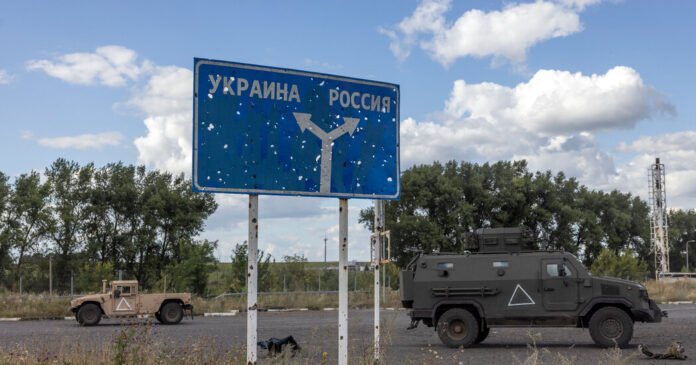President Volodymyr Zelensky has said that Ukraine’s surprise offensive into western Russia, which entered its third week on Tuesday, shows the West that its fears about attacks on Russian territory are unfounded and should be abandoned.
As his forces attempted to push deeper into Russian territory, Mr. Zelensky seized the moment to challenge a limitation from Kyiv’s allies that has long frustrated Ukraine: the use of Western-supplied long-range weapons against Russia, which Ukraine argues is key to disrupting Moscow’s military operations.
“The whole naïve, illusory concept of so-called red lines regarding Russia, which dominated the assessment of the war by some partners, has crumbled these days somewhere near Sudzha,” Mr. Zelensky told Ukrainian ambassadors to other countries in a speech published on Monday evening. He was referring to the western Russian town of Sudzha, which Ukrainian forces captured last week.
For more than two years, Washington has prevented Ukraine from using the weapons it supplied to strike into Russia, citing fears of an escalating conflict between Moscow and the West. This spring, after months of Ukrainian lobbying, the United States and other NATO countries adjusted their policies and granted permission for Ukraine to do that.
But the Biden administration said that Ukraine could only use American weapons to strike military targets a short distance into Russia.
Mr. Zelensky confirmed in his speech to the ambassadors that Ukraine had kept its allies in the dark when preparing for the recent incursion, aware that some partners would object to an operation that “would cross the strictest of all the red lines that Russia has.”
But Moscow’s faltering response to Kyiv’s offensive — defenses near the border collapsed and reinforcements have been slow to arrive — should signal to the world that Russia is not the fearsome superpower it once appeared to be, Mr. Zelensky noted. “It is the time when the world is shedding its last and very naïve illusions about Russia,” he said.
Moscow pledged a response to Ukraine’s incursion soon after it began, but so far its military has not produced a retaliatory operation.
With its offensive, Ukraine has managed to quickly capture several settlements and one town in Russia. But so far, it appears to have failed to fulfill one of its other goals: drawing Russian units from hot spots of the battlefield in eastern Ukraine.
On Tuesday, the Russian Defense Ministry claimed that its troops had captured the eastern Ukrainian town of Niu-York, which took its name in the 19th century, a claim that could not be independently verified. The Ukrainian military said on Tuesday morning that it still held about 20 percent of the town.
Mr. Zelensky’s remarks were some of his harshest critiques yet of Western allies. They highlight the frustration that has been building up in Kyiv, where many officials feel that Western powers, fearful of escalating the fighting, have been careful to offer just enough aid to prevent Ukraine from losing to Russia but not enough to enable it to actually win the war.
Most of the time, Western allies who were initially hesitant eventually endorsed the moves, saying that they were acts of self-defense critical to disrupting Moscow’s military plans.
On Monday, Mr. Zelensky said Ukraine now controlled about 480 square miles of Russian territory. If confirmed, that would represent roughly the same amount of land that Russian forces seized in Ukraine from January through July of this year, according to the Institute for the Study of War, a Washington-based think tank.
The institute said on Monday night that Ukraine had continued to make marginal advances around the territory it had captured in western Russia. But Ukraine’s progress has slowed noticeably in recent days as Russian reinforcements have begun to arrive.
Military experts say that one goal of the offensive is to compel Moscow to divert troops from the front lines in Ukraine to reinforce its own border region. But so far, Russia has withdrawn only a limited number of units from the Ukrainian battlefield and instead continued to press with assaults in the contested eastern Donetsk region, according to Western military analysts and U.S. officials.
Ukraine has also had to draw on its own reserves for the cross-border attack, meaning it could be more difficult for Kyiv to respond to Russian assaults on the eastern front, analysts say.
Ukraine has been quickly losing ground near Pokrovsk, a key city in the Donetsk region, since the cross-border offensive began two weeks ago. And on Monday night, Ukraine’s General Staff said fighting was raging near the eastern towns of Toretsk and Niu-York.
Open-source battlefield maps based on combat footage and satellite images show that most of Niu-York is now under Russian control, although it remained unclear whether Russian troops had fully seized it, as Moscow claimed on Tuesday. Soldiers from the Ukrainian 53rd Brigade fighting near the town told the online news outlet Ukrainian Pravda that they still controlled about a fifth of the settlement but that the Russians kept advancing despite heavy casualties.
For now at least, Kyiv’s cross-border offensive has scored political points. It has lifted public spirits, shifted the narrative that Ukraine was slowly but steadily losing the war and given Mr. Zelensky an opportunity to press allies for more leeway.
“If our partners lifted all the current restrictions on the use of weapons on Russian territory, we would not need to physically enter particularly the Kursk region to protect our Ukrainian citizens in the border communities and eliminate Russia’s potential for aggression,” Mr. Zelensky said on Monday.
The situation on the eastern front is so dire, he added, that “any further delay by our partners in terms of long-range capabilities is becoming de facto, perhaps, the most effective support for Russia’s offensive potential.”
Read More: Zelensky Says Push Into Russia Shows the West’s Red Lines Are ‘Naïve’


